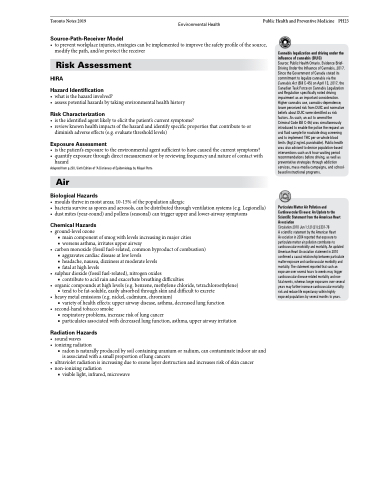Page 1241 - TNFlipTest
P. 1241
Toronto Notes 2019 Environmental Health Public Health and Preventive Medicine PH23
Source-Path-Receiver Model
• topreventworkplaceinjuries,strategiescanbeimplementedtoimprovethesafetyprofileofthesource, modify the path, and/or protect the receiver
Risk Assessment
HIRA
Hazard Identification
• whatisthehazardinvolved?
• assesspotentialhazardsbytakingenvironmentalhealthhistory
Risk Characterization
• istheidentifiedagentlikelytoelicitthepatient’scurrentsymptoms?
• reviewknownhealthimpactsofthehazardandidentifyspecificpropertiesthatcontributetoor
diminish adverse effects (e.g. evaluate threshold levels)
Exposure Assessment
• isthepatient’sexposuretotheenvironmentalagentsufficienttohavecausedthecurrentsymptoms? • quantifyexposurethroughdirectmeasurementorbyreviewingfrequencyandnatureofcontactwith
hazard
Adapted from p.250, Sixth Edition of “A Dictionary of Epidemiology by Miquel Porta
Air
Biological Hazards
• mouldsthriveinmoistareas;10-15%ofthepopulationallergic
• bacteriasurviveassporesandaerosols,canbedistributedthroughventilationsystems(e.g.Legionella) • dustmites(year-round)andpollens(seasonal)cantriggerupperandlower-airwaysymptoms
Chemical Hazards
• ground-levelozone
■ main component of smog with levels increasing in major cities ■ worsens asthma, irritates upper airway
• carbonmonoxide(fossilfuel-related,commonbyproductofcombustion) ■ aggravates cardiac disease at low levels
■ headache,nausea,dizzinessatmoderatelevels
■ fatal at high levels
• sulphurdioxide(fossilfuel-related),nitrogenoxides
■ contribute to acid rain and exacerbate breathing difficulties
• organiccompoundsathighlevels(e.g.benzene,methylenechloride,tetrachloroethylene) ■ tendtobefat-soluble,easilyabsorbedthroughskinanddifficulttoexcrete
• heavymetalemissions(e.g.nickel,cadmium,chromium)
■ variety of health effects: upper airway disease, asthma, decreased lung function
• second-handtobaccosmoke
■ respiratory problems, increase risk of lung cancer
■ particulates associated with decreased lung function, asthma, upper airway irritation
Radiation Hazards
• soundwaves
• ionizingradiation
■ radon is naturally produced by soil containing uranium or radium, can contaminate indoor air and is associated with a small proportion of lung cancers
• ultravioletradiationisincreasingduetoozonelayerdestructionandincreasesriskofskincancer • non-ionizingradiation
■ visible light, infrared, microwave
Cannabis legalization and driving under the influence of cannabis (DUIC)
Source: Public Health Ontario. Evidence Brief- Driving Under the Influence of Cannabis, 2017. Since the Government of Canada stated its commitment to legalize cannabis via the Cannabis Act (Bill C-45) on April 13, 2017, the Canadian Task Force on Cannabis Legalization and Regulation specifically noted driving impairment as an important consideration. Highercannabisuse,cannabis-dependence, lower perceived risk from DUIC and normative beliefs about DUIC were identified as risk factors. As such, an act to amend the Criminal Code Bill C-46) was simultaneously introduced to enable the police the request an oral fluid sample for roadside drug screening and to implement THC per se whole blood limits (>2 ng/mL punishable). Public health was also advised to device population-based interventions such as 6 hour waiting period recommendations before driving, as well as preventative strategies through addiction services, mass-media campaigns, and school- based instructional programs.
Particulate Matter Air Pollution and Cardiovascular Disease: An Update to the Scientific Statement from the American Heart Association
Circulation 2010 Jun 1;121(21):2331-78 AscientificstatementbytheAmericanHeart Association in 2004 reported that exposure to particulate matter air pollution contributes to cardiovascular morbidity and mortality. An updated American Heart Association statement in 2010 confirmed a causal relationship between particulate matterexposureandcardiovascularmorbidityand mortality. The statement reported that such an exposure over several hours to weeks may trigger cardiovascular disease-related mortality and non- fatal events, whereas longer exposures over several years may further increase cardiovascular mortality riskandreducelifeexpectancywithinhighly- exposed populations by several months to years.


